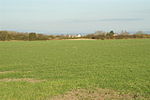Pawlett

Pawlett is a small village 4 miles (6 km) north of Bridgwater, in the Sedgemoor district of the English county of Somerset. The village has Roman or Saxon origins. It has a Norman church and expanded in the 17th and 18th centuries with the draining of the Somerset Levels. During World War II it was the site of an experimental research station into anti-barrage balloon warfare, where experiments were performed to examine ways to use cable cutting devices on the wings of aircraft to sever the cable on which the balloon was flown and thus allow the aircraft to continue on a mission unimpeded. Brave pilots flew their machines into cables to test the effectiveness of these cutters.
Excerpt from the Wikipedia article Pawlett (License: CC BY-SA 3.0, Authors, Images).Pawlett
Old Main Road,
Geographical coordinates (GPS) Address Nearby Places Show on map
Geographical coordinates (GPS)
| Latitude | Longitude |
|---|---|
| N 51.181 ° | E -3.004 ° |
Address
Old Main Road
Old Main Road
TA6 4RY , Pawlett
England, United Kingdom
Open on Google Maps










